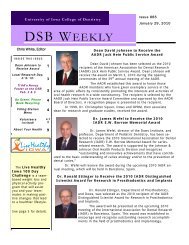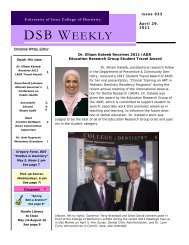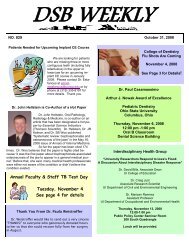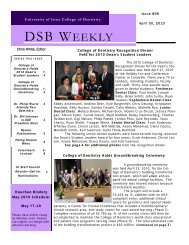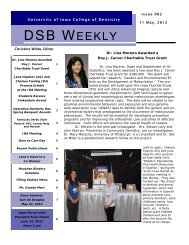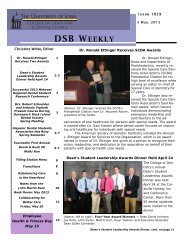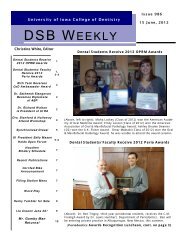Iowa Section of AADR - The University of Iowa College of Dentistry
Iowa Section of AADR - The University of Iowa College of Dentistry
Iowa Section of AADR - The University of Iowa College of Dentistry
Create successful ePaper yourself
Turn your PDF publications into a flip-book with our unique Google optimized e-Paper software.
8. Three-Dimensional S<strong>of</strong>t Tissue Asymmetry in Unaffected Relatives <strong>of</strong> NSCL/P Individuals<br />
E.K. Wang 1 , D.R. Blanchette 1 , C.M. Kummet 1 , S. Miller 1 , L.M. Moreno 1 , D.V. Dawson 1<br />
1 <strong>University</strong> <strong>of</strong> <strong>Iowa</strong><br />
Objectives: To compare patterns <strong>of</strong> three-dimensional facial asymmetry in unaffected siblings <strong>of</strong> individuals with<br />
nonsyndromic cleft lip with or without palate (NSCL/P) to those <strong>of</strong> controls, including assessment <strong>of</strong> feasibility,<br />
developing a diagnostic system for crani<strong>of</strong>acial phenotyping.<br />
Methods: Existing 3D facial scans <strong>of</strong> 51 unaffected siblings (30M/21F) and 29 controls (15M/14F) with no family<br />
history <strong>of</strong> clefting were landmarked by a calibrated rater using 3dMD s<strong>of</strong>tware (Atlanta, GA) for 8 midline and 8<br />
pairs <strong>of</strong> bilateral sites, for a total <strong>of</strong> 24 standard anthropometric s<strong>of</strong>t tissue landmarks . Subject ages ranged from 5<br />
to 16 years (median 10 years). 3D landmark coordinates were extracted and standardized through translation and<br />
were used as measures <strong>of</strong> facial asymmetry. Differences in asymmetry between NSCL/P siblings vs. controls were<br />
assessed using the Wilcoxon Rank Sum test and via multivariate logistic regression to adjust for age and gender.<br />
Analyses were carried out with and without centroid scaling to adjust for facial size.<br />
Results: Feasibility <strong>of</strong> the method was established, with excellent intra-rater reliability (ICCs <strong>of</strong> 0.83 — 0.99 in all<br />
three coordinates <strong>of</strong> 24 landmarks). Evidence was found for an effect <strong>of</strong> age (p=0.037) on crista philtri asymmetry<br />
which strengthened (p=0.0085) after facial size adjustment via centroid scaling; a gender effect was also suggested<br />
measures in relatives <strong>of</strong> NSCL/P cases vs. controls.<br />
Conclusion: S<strong>of</strong>t tissue asymmetry studies are feasible and results from this pilot study will provide useful<br />
information for future well-powered studies, which should consider adjustment for the effects <strong>of</strong> age, facial size, and<br />
gender.<br />
Supported by: NIDCR Training Grant T32 DE014678-09<br />
9. faces.<br />
C.M. Schiltz 1 , J.L. Kolker 1 , J.S. Wefel 1 , C.M. Kummet 1 , M.M. Hogan 1 , J.D. Harless 1 , D.V. Dawson 1<br />
1 <strong>University</strong> <strong>of</strong> <strong>Iowa</strong><br />
Objective: This study aimed to evaluate the effectiveness <strong>of</strong> commercially available, and pr<strong>of</strong>essionally prescribed or<br />
Methods: On 121 non-carious root surfaces a 1mm X 6mm window was created and exposed to a simulated oral<br />
environment. Each surface was randomly assigned to 1 <strong>of</strong> 5 groups: Control, 3M Cavity Shield 5% NaF Varnish<br />
(22,000 ppm — applied once), Oral-B® Neutra-Foam® 2% NaF (9,000 ppm — applied once), PreviDent 5000<br />
Plus TM (5,000 ppm — applied daily), or Crest® Cavity Protection (1,100 ppm — applied daily). For 17 days,<br />
every 24 hours the teeth were exposed cyclically to demineralizing solution (acetic acid - pH 4.3 — 2 hours),<br />
(control, varnish, foam) for 1 hours/min. Teeth were then sectioned, exposing the internal surface <strong>of</strong> the root<br />
windows. Lesion depths were measured using polarized light microscopy and Image Pro Plus computer s<strong>of</strong>tware.<br />
Descriptive statistics, ANOVA, and pairwise comparisons were performed using SAS 9.2 and R statistical s<strong>of</strong>tware.<br />
Results:<br />
highest in the control group (144.52 µm) followed by Neutra-foam (128.63 µm), Varnish (120.18 µm), Crest (85.37<br />
each other after adjustment for multiple comparisons to preserve an overall Type I error <strong>of</strong> 0.05 (Tukey-Kramer<br />
adjusted p=0.0492 for 3M Cavity Shield Varnish and Neutra-Foam comparison and adjusted p



